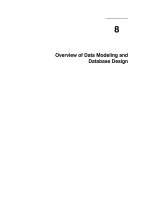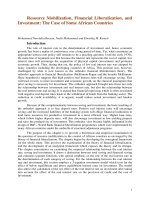Tài liệu Impact of Government Policies and Investment Agreements on FDI Inflows to Developing Countries: An Empirical Evidence doc
Bạn đang xem bản rút gọn của tài liệu. Xem và tải ngay bản đầy đủ của tài liệu tại đây (284.96 KB, 41 trang )
Impact of Government Policies and Investment Agreements on
FDI Inflows to Developing Countries: An Empirical Evidence
Rashmi Banga
•
Abstract
The last two decades have witnessed an extensive growth in foreign direct investment
(FDI) flows to developing countries. This has been accompanied by an increase in
competition amongst the developing countries to attract FDI, resulting in a rise in
investment incentives offered by the host governments and removal of restrictions on
operations of foreign firms in their countries. This has also led to an ever-increasing
number of bilateral investment treaties (BITs) and regional agreements on
investments. In this scenario, the question addressed by the study is: How effective
are these selective government policies and investment agreements in attracting FDI
flows to developing countries and do FDI from developed and developing countries
respond similarly to developing host countries’ policies? To answer this, the study
examines the impact of fiscal incentives offered, removal of restrictions and signing
of bilateral and regional investment agreements with developed and developing
countries on FDI inflows to developing countries, after controlling for the effect of
economic fundamentals of the host countries.
The analysis is first undertaken for aggregate FDI inflows to fifteen developing
countries of South, East and South East Asia for the period 1980-81 to 1999-2000.
Separate analyses are then undertaken for FDI from developed and developing
countries. The results based on random effects model show that fiscal incentives do
not have any significant impact on aggregate FDI, but removal of restrictions attracts
aggregate FDI. However, FDI from developed and developing countries are attracted
to different selective policies. While lowering of restrictions attract FDI from
developed countries, fiscal incentives and lower tariffs attract FDI from developing
countries. Interestingly, BITs, which emphasize on non-discriminatory treatment of
FDI, are found to have a significant impact on aggregate FDI. But it is BITs with
developed countries rather than developing countries that are found to have a
significant impact on FDI inflows to developing countries.
JEL Code: F21
Keywords: Foreign Direct Investment, selective government policies, Bilateral Investment Treaties,
FDI from Developed and developing countries
•
I thank Indian Council for Research on International Economic Relations (ICRIER) for funding this
study. I am extremely grateful to Dr. Arvind Virmani (ICRIER), Prof. K.L.Krishna (ICRIER) and Prof.
B.N.Goldar (ICRIER) for their valuable insights and suggestions. The usual disclaimer nevertheless
applies.
1
1. Introduction:
The ongoing process of integration of the world economy has led to a significant
change in the attitudes of the host countries with respect to inward foreign direct
investment (FDI). FDI is no longer regarded with suspicion by the developing
countries and controls and restrictions over the entry and operations of foreign firms
are now being replaced by selective policies aimed at FDI inflows, like incentives,
both fiscal and in kind. An international legal framework for FDI has also begun to
emerge to protect the interests of foreign investors. Along with this, in the last decade,
there has emerged an extensive network of bilateral investment treaties and regional
investment agreements, which seek to promote and protect FDI coming from the
partner countries. The main provisions of these agreements whether bilateral or
regional, is linked with gradual decrease or elimination of measures and restrictions
on the entry and operations of foreign firms and application of positive standards of
treatment with a view to eliminate discrimination against foreign enterprises.
With this in the background, it can be said that FDI may no longer be attracted to just
economic fundamentals of the host economy and therefore governments of the
developing countries have a far greater role to play. Along with the policies that
improve the fundamentals of the economy they also need to develop selective policies
that aim at attracting more foreign investments. With expanded markets and increased
volumes of trade, the motives of FDI have become far more complex than in the past.
Moreover, with the growth of FDI flows from the developing countries in the last two
decades, it is possible that FDI from developed and developing countries may seek to
fulfill different objectives and therefore may be attracted to different set of policies of
the host governments. This has also been observed by
Dunning (2002), who suggest
2
that for FDI from large developing countries traditional economic variables remain more
important. But, FDI from more advanced industrialized countries is increasingly seeking
complementary knowledge intensive resources and capabilities, a supportive and
transparent commercial, legal communications infrastructure, and government policies
favorable to globalization, innovation and entrepreneurship. This, however, remains to be
tested empirically.
There is now a need to study afresh what determines cross-country pattern of FDI.
Recently, there have been some studies that have analysed the importance of
government policies in determining inward FDI (Dunning 2002, Blomsrom and
Kokko 2002). However, very few studies exist that have empirically estimated the
impact of selective government policies aimed at FDI and none has examined the
response of FDI from developed and developing countries to these selective policies.
Along with the fiscal incentives offered to foreign firms what may determine inflow
of FDI is the treatment of FDI in the host countries, which is ensured by bilateral and
regional investment agreements. With the growing importance these investment
agreements there is also a need to empirically examine their impact on FDI inflows
and investigate whether bilateral investment agreements with developed and
developing countries have differential impact on FDI inflows.
The study is a first attempt that empirically estimates the impact of bilateral
investment agreements with developed and developing countries on FDI inflows from
developed and developing countries. It estimates the impact of government policies
and investment agreements on FDI inflows in sixteen developing countries of South,
East and South East Asia for the period 1980-81 to 1999-2000. Further, it
3
disaggregates FDI into FDI approvals from developed and developing countries and
studies their response to government policies and investment agreements in the period
1986-1987 to 1996-1997
1
. Random Effects Model and Fixed Effects Model have been
estimated using panel data for the analyses.
The study has eight sections. Section 2 examines the trends in FDI Flows to
developing countries of Asia. Section 3 presents the theoretical framework and
discusses the earlier research. Section 4 specifies the model to be estimated. Section 5
discusses the variables, data sources and expected relationships with the variables.
Section 6 and 7 presents the results on determinants of aggregate FDI and
determinants of FDI from developed and developing countries respectively. Section 8
summarizes and concludes.
2. Trends in FDI Flows to Developing Countries of Asia
There has been a tremendous increase in global FDI flows in the last two decades.
This has also been accompanied by a slow shift in the pattern of FDI, which has
gradually become more favourable to the developing countries. Table 1 presents the
percentage of global FDI flows into developed and developing countries and from
developed and developing countries in this period. We find that the share of
developing countries in total inward FDI has steadily increased. The average annual
percentage flow of FDI into developing countries rose from 25 percent in the 1980s to
30 percent in 1990s. This average would have been much higher in the 1990s but for
the slow down of the Asian economies after 1997. The average annual outflow of FDI
from developing countries has almost doubled in the 1990s as compared to 1980s
though an increasing proportion of FDI outflows, i.e., around 88 percent still comes
from the developed countries.
1
The period is selected depending on the availability of data.
4
Amongst the developing regions, we find that the share of Asia and Pacific has
increased steadily in the last two decades
2
. The average annual inflow of FDI into
Asia and Pacific increased to around 54 per cent in the 1980s to around 61% in the
1990s. The distribution of FDI inflows between Asia and Pacific is biased heavily
towards the Asian countries. The average annual inflow into Asian countries in the
1980s was around 97 per cent, this further increased to around 99 percent in the
1990s. Within Asia, we find that on an average 72%of total FDI went to South, East
and South East Asia in the 1980s and around 97% in the 1990s.
Table 1: Percentage of Global FDI Inflows and Outflows: 1980-2001
YEAR FDI inflows into FDI outflows from
Developed
Countries
Developing
Countries
Developed
Countries
Developing
Countries
1980 84.68 15.25 93.79 6.17
1981 66.04 33.91 96.08 3.92
1982 54.04 45.93 90.20 9.79
1983 65.40 34.53 95.39 4.60
1984 69.44 30.53 95.66 4.32
1985 74.13 25.82 93.15 6.85
1986 81.04 18.97 94.75 5.22
1987 83.37 16.62 95.20 4.80
1988 81.40 18.57 93.24 6.74
1989 84.49 15.26 92.82 7.18
Average 74.40 25.54 94.02 5.96
1990 81.16 18.53 92.82 7.16
1991 70.60 27.71 93.97 6.01
1992 62.67 34.60 87.43 12.53
1993 60.28 36.61 83.69 16.18
1994 55.71 41.86 83.35 16.48
1995 61.51 34.05 85.34 14.46
1996 56.95 39.54 84.15 15.52
1997 56.05 39.96 83.33 15.78
1998 69.73 27.02 92.29 7.35
1999 76.98 20.69 92.70 7.07
2000 82.27 15.95 92.16 7.55
2001 68.44 27.86 93.54 5.89
Average 66.86 30.36 87.79 11.00
Source: UNCTAD 2003. Total FDI flows are divided between developed countries,
developing countries and Central and Eastern Europe
2
UNCTAD 2003
5
Within the Asian developing countries (Table 2), it is interesting to note that the
average share of countries in FDI inflow has changed substantially in the last two
decades. China has seen a substantial increase in its average share of total FDI inflow
into this region in the 1990s. The average share of FDI inflow has also increased in
the 1990s for countries like Bangladesh, India and Vietnam, though their overall share
in the 1990s still remains very low. But the average share of Malaysia and Hong Kong
has declined from around 15 to 8 per cent and 22 to 17 per cent respectively in the
decade of the 1990s. Some fall is also seen in the average shares of Taiwan,
Indonesia, Pakistan, Sri Lanka and Thailand during this period.
However, the average shares of these countries in total stock of FDI in this region, in
the period 1980 to 2001, shows a very different picture. Hong Kong has received
around 50 per cent of the total stock of FDI in these two decades. While 15 per cent of
the total FDI stock has gone into China, which is followed by Indonesia at around 10
percent and Singapore at around 8 per cent. Thailand and Taiwan have received
around 2 per cent of the total FDI stock and all others have received less than 1 per
cent share in total FDI stock into this region.
Table 3 reports the average share of FDI inflows from developed and developing
countries into these countries in the period 1986-87 to 1996-97
3
. It is interesting to
note that Singapore has received the largest share of FDI from the developed countries
3
These averages are based on FDI approvals and not actual inflows.
6
followed by Hong Kong, Korea and Indonesia. Countries like Taiwan, India,
Thailand, Philippines, Malaysia and Pakistan have received more than 50 per cent of
their FDI from the developed countries. The rest have a larger share of FDI from the
developing countries. Interestingly, China and Vietnam have more than 60 per cent of
FDI inflows from developing countries.
Table2: Average Share of Countries in Total FDI Inflows and Total FDI Stock in
South, East and South East Asia: 1980 to 2001.
Average Share in
Total FDI Inflow
1980-1990
Average Share in
Total FDI inflow
1991-2001
Average Share in
Total FDI
Inward Stock
1980-2001
Bangladesh 0.04 0.08 0.05
China 16.46 40.62 15.35
China, Hong Kong 22.13 16.87 50.96
China, Taiwan 4.73 3.03 2.49
India 1.29 2.07 0.90
Indonesia 4.12 2.68 10.23
Korea 3.43 3.98 1.97
Malaysia 14.88 8.18 0.01
Nepal 0.0001 0.0001 0.00
Pakistan 1.11 0.77 0.68
Philippines 1.49 1.90 1.16
Singapore 23.83 11.82 8.49
Sri Lanka 0.62 0.25 0.24
Thailand 5.38 4.84 2.10
Vietnam 0.13 1.59 0.52
Others 0.36 1.32 4.84
Total South, East and
South East Asia
100.00 100.00 100.00
Computed from UNCTAD
7
Table3: Average Share of FDI Inflows from Developed and Developing
Countries: 1986-87 to and 1996-97.
Country FDI from Developed
Countries
FDI from
Developing
Countries
Total
Bangladesh 36.02 63.98 100
China 23.64 76.36 100
China, Hong Kong 83.32 16.68 100
China, Taiwan 63.05 36.95 100
India 68.47 31.53 100
Indonesia 81.26 18.74 100
Korea, Rep. 86.50 13.50 100
Malaysia 57.55 42.45 100
Nepal 46.92 53.08 100
Pakistan 73.27 26.73 100
Philippines 72.41 27.59 100
Singapore 96.36 3.64 100
Sri Lanka 36.77 63.23 100
Thailand 63.72 36.28 100
Vietnam 33.51 66.49 100
Source: World Investment Directory, Vol VII-Part 1&2: Asia and the Pacific.
The figures are based on Approvals for FDI.
3.Theoretical Framework and Earlier Research:
The emergence of FDI has been extensively explained by three corresponding streams
of thoughts. First, the market imperfections hypothesis (Hymer 1976), which
postulates that FDI is the direct result of an imperfect global market, second, the
internalisation theory (Rugman 1986), where FDI takes place as multinationals
replace external markets with more efficient internal ones, and third, the eclectic
approach to international production (Dunning 1988) where FDI emerges due to
ownership, internalisation and locatonal advantages. The development in different
theories of FDI has been surveyed by Dunning (1999).
What interests us is the determinants of cross-country pattern of FDI. There is an
extensive empirical literature on determinants of inward FDI that emphasises the
8
economic conditions or fundamentals of the host countries relative to the home
countries of FDI as determinants of FDI flows. This literature is in line with
Dunning’s eclectic paradigm (1993), which suggests that it is the locational
advantages of the host countries that determines cross-country pattern of FDI.
However, it has been argued that the location specific advantages sought by mobile
investors are changing in the globalised scenario. According to Dunning (2002), for
FDI from more advanced industrialised countries, government policies along with
transparent governance and supportive infrastructure has become more important.
While, FDI emerging from larger developing countries still seek traditional economic
determinants, e.g., market size and income levels, skills, infrastructure and other
resources that facilitate efficient specialisation of production, and political and
macroeconomic stability. This, however, remains to be tested empirically.
There exists a vast literature that has analysed the impact of economic fundamentals
on inflow of FDI. The most important of these economic fundamentals, as recognised
in the literature are the market-related variables. Here, there are two market familiar
factors, i.e., current market size and potential market size. While a large market size
generates scale economies, a growing market improves the prospects of market
potential and thereby attracts FDI flows (Bhattacharya et al 1996, Chen and Khan
1997, Mbekeani 1997). Other economic fundamentals that are recognised with
varying degrees of significance are availability of skilled manpower, cost of labour,
cost of capital, availability of infrastructure and political and macroeconomic stability
in the host countries (UNCTC 1992, Schneider and Frey 1985).
9
Apart from the market related factors studies have suggested selective government
policies e.g., fiscal incentives and removal of entry restrictions as important
determinant of FDI inflows. Brewer (1993) discuses various types of government
policies that can directly and indirectly affect FDI through their effects on market
imperfections. However, the empirical evidence on the impact of selective
government policies on FDI inflows is mixed. Some of the studies that find positive
effect of investment incentives and negative impact of performance requirements are
Grubert and Mutti (1991), Loree and Guisinger (1995), Taylor (2000) and Kumar
(2002). But, UNCTAD (1996) reports that incentives can have an effect on attracting
FDI only at the margin, especially when one considers the type of incentive and the
type of project. Several studies find that fiscal incentives do affect location decisions,
especially for export oriented FDI, although other incentives seem to play a secondary
role (see Devereux and Griffith 1998; Hines 1996). Blomstrom and Kokko (2002)
have further discussed whether FDI incentives are justified for the host economies
given the fact that this entails a transfer of resources from host countries to foreign
firms.
But there are studies e.g., Contractor (1991) that find policy changes to have a weak
influence on FDI inflows. Caves (1996) and Villela and Barreix (2002) conclude that
incentives are generally ineffective once the role of fundamental determinants of FDI
is taken into account. This view is also supported by Hoekman and Saggi (2000) who
conclude that although useful for attracting certain types of FDI, incentives do not
seem to work when applied at an economy wide level. In a recent paper, Nunnenkamp
(2002) argues that little has changed since 1980s and traditional market related
determinants are still dominant factors attracting FDI.
10
A subset of these studies have tested the impact of openness to trade and regional
agreements for trade on FDI inflows and found them to be important determinants in
the 1990s decade [e.g., Gastanaga, Nugent and Pashmova (1998), Taylor (2000),
Chakrabarti (2001) and Asiedu (2002)]. Globerman and Shapiro (1999) have found
that Canada-U.S. Free Trade Agreement (CUFTA) and North American Free Trade
Agreement (NAFTA) increased both inward and outward FDI. Blomstrom and
Kokko (1997) separate the effects of regional trade agreements (RTA) along two
dimensions, i.e., the indirect effect on FDI through trade liberalisation and the direct
effects from changes in investment rules connected with the regional trade
agreements. According to them lowering interregional tariffs can lead to expanded
markets and increase FDI but lowering external tariffs can reduce FDI to the region if
the FDI is tariff jumping.
The present study adds to the existing literature by empirically examining the
response of FDI to selective FDI policies, namely tariff policy, fiscal incentives
offered and removal of restrictions in the host developing countries. Further, it
examines the response of FDI from developed and developing countries to the host
countries' selective FDI policies. The study is the first attempt to test empirically the
significance of bilateral investment treaties and regional investment agreements in
attracting FDI flows to developing countries. It also investigates whether signing
bilateral investment treaties and regional investment agreements with developed
countries and developing countries have differential impact on FDI inflows.
11
4. Model Specification
Based on their susceptibility to change, the policies of the government that influence
inward FDI can be categorised into three groups. First, fundamental policies, i.e.,
those that affect the economic fundamentals of the economy, e.g., market size,
availability of skilled labour, etc. Second, selective policies, i.e., those that aim at
short run selective objectives (in this case attracting inward FDI) and third those that
are international in nature, e.g., signing bilateral investment treaties and regional
investment agreements.
Both theoretically and empirically, the separation of policies into these three
categories seems logical, given the desires of the host countries’ governments to
manipulate policies to attract greater FDI flows. While fundamental policies may take
a long time to change the economic conditions of the economy, selective policies may
have a more immediate effect. Signing of investment agreements to encourage FDI
flows from a particular country or from within a region is a matter of international
policy of the host country’s government and though it is easier to enter such
agreements these may not be susceptible to changes in the short run. The focus of the
study is on the selective policies and the international policies of the government after
controlling for the economic fundamentals of the economy.
The model formulated for this purpose estimates the impact of three types of selective
government polices to attract FDI after controlling for the economic fundamentals of
the economy as alternative explanations. These are the tariff policies that affect the
extent of openness of the economy in the short run, fiscal incentives offered to
12
foreign firms and removal of restrictions on the operations of foreign firms in the host
country. Signing of bilateral and regional investment agreements with developed and
developing countries is also introduced as a determinant in the model. Thus the model
to be estimated is as follows:
FDI
it
= f [(Economic Fundamental)
it-1
, (Tariff Policies)
it
,(FDI Incentives)
it ,
(Removal of Restrictions on FDI)
it ,
, (Bilateral Investment Agreements)
dgct
, (Bilateral
Investment Agreements)
dct
, (Regional Investment Agreements)
it
]
where i stands for country and t stands for the time period = 1980-81, 1981-
82…..1999-2000. dgc stands for developing countries and dc for developed countries
i.e., (Bilateral Investment Agreements)
dgct
stands for bilateral investment agreement
with developing countries. Impact of economic fundamentals is estimated with a lag
of one period to avoid simultaneity with the dependent variable. A similar model is
estimated for FDI from developed countries and FDI from developing countries for
the period 1986-87 to 1996-97 based on FDI approvals. The impact of two regional
investment agreements is examined, i.e., agreement reached among the APEC
members, i.e., non-binding investment principles (NBIP) and investment area
agreement (AIA) reached by Association of Southeast Asian Nations (ASEAN).
These are captured by a dummy variable for the country’s membership of ASEAN
and APEC. We now discuss in detail the methodology adopted and variables selected
for the above specified model along with their data source.
13
5. Variables, Data Sources and Expected Relationships
I) Economic Fundamentals as determinant of FDI
Drawing on the vast existing literature on the economic fundamentals that have been
considered as determinants of inward FDI, we control for the market variables (i.e.,
market size and potential market size), cost variables (i.e., cost of labour in terms of
efficiency wages and cost of capital), human capital (i.e., education), macro-economic
stability (i.e., exchange rate depreciation and exchange rate stability), financial health
(i.e., budget deficit and level of external debt) and infrastructure availability (i.e.,
transport and communication and electricity consumed) in the economy. Studies have
found market variables, quality of human capital, macro economic stability, financial
health and infrastructure availability in the economy to have a positive impact while
cost variables are expected to be negatively related to FDI inflows (UNCTC 1992).
The definitions of the above variables along with their expected signs as inferred from
the literature are presented in Table 4. The sources of data are reported in Table A.1
of the Appendix.
Table 4: Variables, Definition and Expected Signs
Variables Abbreviation Definition Expect
ed
Signs
1. Log of FDI Log of Foreign Direct Investment
Inflows
2. Market Size MKTSIZE Log of real gross domestic product +
3. Potential Market Size GRTHMKT Growth rate of real GDP +
4. Efficiency Wage Rate EFFWAGE Labour Cost / Labour Productivity -
5. Education EDU Log of secondary enrolment ratio +
6 Real exchange Rate EXRATE Real effective exchange rates -
7. Financial Health: EXTDEBT Ratio of external Debts toexports +
8. Budget Deficit BUDGETDEF Budget Deficit / GDP +
9. Transport and Commu T&C Transport & Communication/ GDP +
10. Electricity Consumed ELECT Electricity Consumed/GDP +
11. Lending Rate LDRATE Real domestic interest rates -
12. Exchange rate
Volatility
EXGVOL
Percentage Change in Annual
exchange rate between local currency
and one US $
-
14
II) Selective Government policies
Government policies as a determinant of cross-country pattern of FDI flows have
assumed greater importance in the current liberalised regime. However as observed by
Globerman and Shapiro (1999) it is difficult to statistically examine FDI–specific
policies since they are hard to isolate from other factors, “often because they are more
implicit than explicit”. Another of the difficulties in empirically examining the impact
of these policies is the difficulty in quantifying these policies.
Studies that have empirically found a significant impact of government policies on
FDI flows are generally based on benchmark surveys at a point of time (Kumar 2002,
Loree and Guisinger 1995) or observe the impact of government policies on inward
FDI for a particular country over a period of time. Though these kinds of studies give
an insight into what determines the pattern of FDI flows at a particular point in time,
they do not capture the influence of change in the FDI policies in a particular country
and its comparative attractiveness to inward FDI into that region overtime.
FDI may flow into a country not only because now the host country provides certain
investment incentives but also because these incentives when compared to the
incentives provided by other competing host countries appear to be more attractive.
Also, an important fact that needs to be addressed is that though when considered
individually different incentives offered by a host country may have significant
influence on FDI, but when considered as a package, i.e., when all incentives offered
by one host country are compared to those offered by other host country these
incentives may lose their significance.
15
In an attempt to address the above issues and to quantify policies that are not captured
by proxy variables and make them comparable across countries the methodology
adopted is to allot scores to different countries for the policies offered by them
overtime. These scores range from 0 to 2, where a zero score is allotted to a country at
a time when no incentives are offered by it. The score 1 or 2 is allotted for different
incentive offered depending upon how conducive they are in attracting FDI. For
example, in case of tax holidays offered, a score is given to a country for the period
depending on number of years for which tax holidays are offered. A zero score is
alloted if no tax holidays are offered. A country gets a score of 1 if the tax holidays
are offered for a period of less than five years. A score of 2 is assigned if tax holidays
are offered for a period more than five years.
Different scores with respect to different incentives have been allotted and their
influence of FDI flows is empirically tested. But along with this the impact of
composite score for incentives allotted to each country, i.e., a sum of all the scores
allotted to it in a particular year for different incentives, is also examined. The
influence of combined score on FDI flows allows us to see how important is the
influence of the entire package of incentives offered by the host country. A similar
exercise is undertaken with respect to removal of restrictions. The selective polices
and their expected impact is now discussed:









